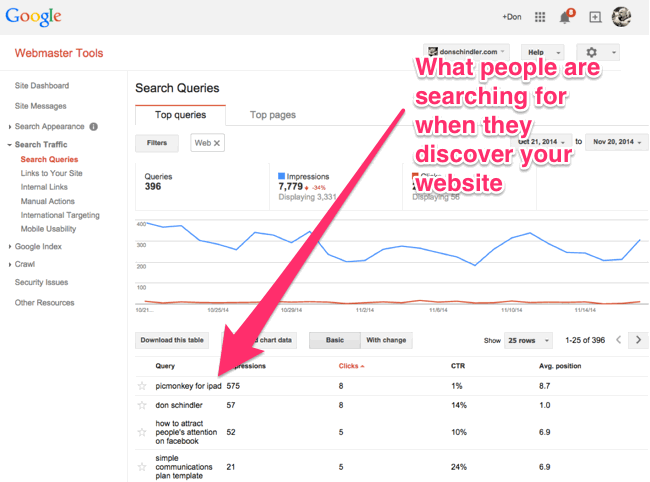
Being found on the web is getting harder and harder to do.
The big brands are finally catching up to how the search engines see them and they are now putting substantial budgets into paid and organic search and social campaigns in order to be found on the first page of Google (for their important keywords).
So how do you compete?
Well, there are a lot of ways to compete but you need to have the basics down first.
In my workshop on search engine optimization or the better term for it, search experience optimization (SEO), I break down the basics and try to shed some light on simple things you can do to make sure the search engines and the people using those search engines see you. Because if they can’t see you, then you don’t exist.
Here’s the deck I used. Now you can flip through the deck if you want but it doesn’t have the text that you’ll have here.
When it comes to SEO, the first thing you have to do is produce good content. I know that sounds silly and like my friend Erik Deckers says, “Telling people to produce good content is stupid.”
That’s so true.
You need good content but you have to understand what makes good content and how to produce it specifically for your desired audience.
I like to say that good content is all about making people laugh, cry or think about your subject matter. If you can do that, then you have exactly what they are looking for. They will read it, watch it and share it.
Sharing is very important in this day and age of social.
Buzzfeed (who is one of the reigning kings of sharing content) talks about how they produce good content. You should read it and try to incorporate what they do to produce it.
If you’ve got the content down, then SEO gets pretty simple.
I like to break it down into these 8 things that you should focus on.
1. Content Strategy is basically what should be on the website when it launches and what will you continue to add to it. This is taking your good content and making sure it is focused on your subject matter. Once you have that down, your website should be able to handle these simple questions for both the users and the search engines.
- Who You Are
- What You Do
- Where You’re Located
- Your Value Proposition
- What Visitors Should Do Next
2. Platform Strategy is knowing what devices your content is on and how your users see them. The platforms I believe you should worry about are iOS & Android first. Mobile is how people are connecting them most. I’ll have more on that later. Then you need to verify how you look in Chrome, Internet Explorer, Firefox, and Safari.
There are two testing tools I like – www.browserstack.com (paid with free trial) and www.browserling.com (free but more features with paid).
3. Information Architecture is how things are laid out on your website (goals, navigation, search, calls to action). Essentially where the content will go. I love that more and more sites are moving to the “hamburger patty” navigation button and essentially hiding standard navigation.
Instead of driving people’s attention away from the content, the hidden navigation will help get your Call-to-Action noticed more and that’s the whole point of the website, right?
4. Keyword Research will help you understand what terms your users are using to find your type of content. Why guess when the search engines can tell you what terms you should be using and what terms you are currently indexed for.
I like using Google’s Adword Keyword Planner tool as well as Soolve to discover more familiar terms.
5. Usability and User Interface are two separate things but they really revolve around each other. I believe you can’t have good Usability without good User Interface and vice versa.
When I think about usability, I’m worried about how easy is it for a user to navigate the site? Do they understand your Call-to-Action? Are they incentivized to do it?
6. When I’m thinking about User Interface, you should be focused on the mobile website vs. the desktop for the first experience. The mobile version in responsive design will really teach you what is most important then you can focus on that when you start doing the desktop design. You should be focused on touch (thumb size) instead of mouse clicks as well as more and more screens become touch sensitive.
Color/design mean everything to the user. Check out my post on digital body language to understand more of how to be intentional with everything the user sees so they will do what you want them to do.
7. Accessibility is important because everyone should be able to view your content including those with disabilities. I’ve been told that up to 25% of your audiences can have vision problems and you can help them by making your website 508 compliant.
Check out 508checker.com and boia.org to help you get 508 compliant.
8. Last but definitely not lead is Inbound Links. These are the amount and strength of other websites hyperlinking to your website. The more you have based on your subject matter, the more the search engines will look to you as an authority in that subject matter.
You used to be able to manipulate these inbound links with blog farms and other black hat techniques but the search engines, especially Google, is constantly on the hunt to keep their search from being gamed. So it’s better to just focus on great content and asking people to link/talk about you on their websites.
You should definitely have a distribution strategy to execute upon when you put out great content. I love using email, social networks, blogging networks, etc… to encourage people to visit the content when we get it up on the website.
Now let’s touch on tools I use to find out what’s going on with the website.
First there’s Google Analytics and Google Webmaster Tools.
I have an article on how you can get them both set up and connected together.

Once you have that you can start looking at what you are being found for currently and then adjusting to be found for other keywords.
Google Webmaster Tools will also let you sort of control your most popular navigational links so you should have know what those are.
Also Google Webmaster tools is going to tell you a lot about how Google sees your website, from mobile experience to your 404 broken link / missing page issues.
Speaking of 404 broken links and missing pages, I use Xenu to scan websites and get a report of what’s wrong with them so I can check. It’s simple program (free) that anyone on a PC can download. Since I’m on a mac I use Wine to run the program.
Here’s a link to my article on how to fix 404 issues.

Next up with SEO tactics are your images. It’s pretty simple to fix these. All you need is a process. I would not recommend going back and fixing all your image SEO problems unless the images are on your most popular pages. You can find what your most popular pages are in your Google Analytics. Just click on Behavior > Site Content > All Pages and you’ll get a list.
Here’s my article on how to fix images to make them SEO friendly.

Finally let’s talk about website Title Tags and Meta Description. You should use real keywords within your Title Tags because the domain URL is going to be very important to the search engines. They especially don’t like numbers or non-sensical titles.
Meta-Descriptions have been seriously downgraded for SEO if they were even a part of the search algorithm in the first place but they are seriously important to the Google Snippet which people read about the page they are visiting. If you don’t fill this out, Google will pull any text on the page that it thinks describes the website. You don’t want that to happen.
Here’s my post on how to do Title Tags and Meta-Descriptions.

So this was my workshop on Search Experience Optimization (former Search Engine Optimization). Do you have things you would like to add to it?
Leave a Reply